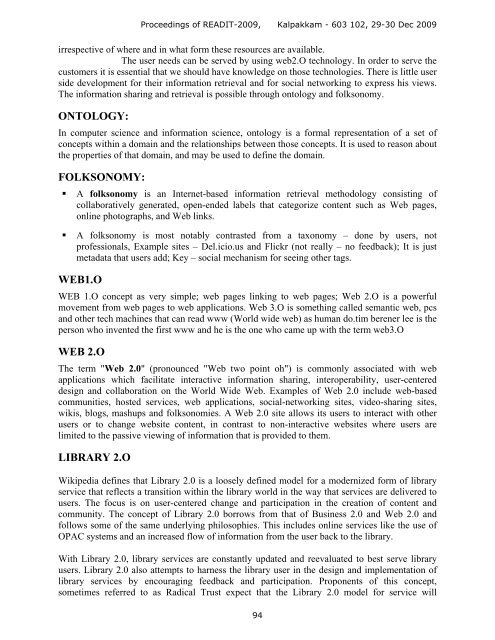READIT - 2009 - Indira Gandhi Centre for Atomic Research
READIT - 2009 - Indira Gandhi Centre for Atomic Research
READIT - 2009 - Indira Gandhi Centre for Atomic Research
You also want an ePaper? Increase the reach of your titles
YUMPU automatically turns print PDFs into web optimized ePapers that Google loves.
Proceedings of <strong>READIT</strong>-<strong>2009</strong>, Kalpakkam - 603 102, 29-30 Dec <strong>2009</strong><br />
irrespective of where and in what <strong>for</strong>m these resources are available.<br />
The user needs can be served by using web2.O technology. In order to serve the<br />
customers it is essential that we should have knowledge on those technologies. There is little user<br />
side development <strong>for</strong> their in<strong>for</strong>mation retrieval and <strong>for</strong> social networking to express his views.<br />
The in<strong>for</strong>mation sharing and retrieval is possible through ontology and folksonomy.<br />
ONTOLOGY:<br />
In computer science and in<strong>for</strong>mation science, ontology is a <strong>for</strong>mal representation of a set of<br />
concepts within a domain and the relationships between those concepts. It is used to reason about<br />
the properties of that domain, and may be used to define the domain.<br />
FOLKSONOMY:<br />
• A folksonomy is an Internet-based in<strong>for</strong>mation retrieval methodology consisting of<br />
collaboratively generated, open-ended labels that categorize content such as Web pages,<br />
online photographs, and Web links.<br />
• A folksonomy is most notably contrasted from a taxonomy – done by users, not<br />
professionals, Example sites – Del.icio.us and Flickr (not really – no feedback); It is just<br />
metadata that users add; Key – social mechanism <strong>for</strong> seeing other tags.<br />
WEB1.O<br />
WEB 1.O concept as very simple; web pages linking to web pages; Web 2.O is a powerful<br />
movement from web pages to web applications. Web 3.O is something called semantic web, pcs<br />
and other tech machines that can read www (World wide web) as human do.tim berener lee is the<br />
person who invented the first www and he is the one who came up with the term web3.O<br />
WEB 2.O<br />
The term "Web 2.0" (pronounced "Web two point oh") is commonly associated with web<br />
applications which facilitate interactive in<strong>for</strong>mation sharing, interoperability, user-centered<br />
design and collaboration on the World Wide Web. Examples of Web 2.0 include web-based<br />
communities, hosted services, web applications, social-networking sites, video-sharing sites,<br />
wikis, blogs, mashups and folksonomies. A Web 2.0 site allows its users to interact with other<br />
users or to change website content, in contrast to non-interactive websites where users are<br />
limited to the passive viewing of in<strong>for</strong>mation that is provided to them.<br />
LIBRARY 2.O<br />
Wikipedia defines that Library 2.0 is a loosely defined model <strong>for</strong> a modernized <strong>for</strong>m of library<br />
service that reflects a transition within the library world in the way that services are delivered to<br />
users. The focus is on user-centered change and participation in the creation of content and<br />
community. The concept of Library 2.0 borrows from that of Business 2.0 and Web 2.0 and<br />
follows some of the same underlying philosophies. This includes online services like the use of<br />
OPAC systems and an increased flow of in<strong>for</strong>mation from the user back to the library.<br />
With Library 2.0, library services are constantly updated and reevaluated to best serve library<br />
users. Library 2.0 also attempts to harness the library user in the design and implementation of<br />
library services by encouraging feedback and participation. Proponents of this concept,<br />
sometimes referred to as Radical Trust expect that the Library 2.0 model <strong>for</strong> service will<br />
94

















